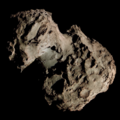C/2021 O3 (PanSTARRS)
| Discovery[1] | |
|---|---|
| Discovered by | Robert Weryk |
| Discovery site | Pan-STARRS |
| Discovery date | 26 July 2021 |
| Orbital characteristics[2][3] | |
| Epoch | 30 October 2021 (JD 2459517.5) |
| Observation arc | 351 days |
| Number of observations | 760 |
| Orbit type | Oort cloud |
| Perihelion | 0.287 AU |
| Eccentricity | 1.00015 |
| Inclination | 56.75° |
| 189.03° | |
| Argument of periapsis | 299.98° |
| Mean anomaly | –0.002° |
| Last perihelion | 21 April 2022 |
| TJupiter | 0.446 |
| Earth MOID | 0.063 AU |
| Jupiter MOID | 2.165 AU |
| Physical characteristics[5] | |
Mean radius | ~1.0–1.7 km (0.62–1.06 mi) |
| 0.04 (assumed) | |
| Comet total magnitude (M1) | 10.6 |
| 7.6 (2022 apparition)[4] | |
C/2021 O3 (PanSTARRS) is a hyperbolic Oort cloud comet discovered on 26 July 2021 by the Pan-STARRS sky survey. It came to perihelion on 21 April 2022 at 0.287 AU (42.9 million km) from the Sun.
Observational history
[edit]The comet was expected to reach apparent magnitude 5.0 by late April 2022, while being only 15 degrees from the Sun.[1][6] While near perihelion the comet was dimmer than expectations, only reaching magnitude 7.6 at its peak brightness on 19 April 2022.[4] It was faintly visible in STEREO/SECCHI COR2-A on 27 April 2022.[7] Observations by Lowell Discovery Telescope on 29 April in the twilight detected a diffuse glow with a magnitude of 9.0 where the comet was expected to be, indicating that its nucleus disintegrated during perihelion,[8] however follow-up studies in 2025 revealed that this is unlikely and the comet remains intact post-perihelion.[5] C/2021 O3 made its closest approach to Earth on 8 May 2022 at a distance of 0.60 AU (90 million km).[9]
The comet was recovered by multiple observatories after perihelion at magnitudes not too different from those observed pre-perihelion.[10] Calculations carried out using the pre- and post-perihelion orbits indicate that although the comet is probably dynamically old, it may also be a fragment of a dynamically new comet that was released during the first perihelion passage of its parent comet.[10][11]
Orbit
[edit]
With a short observation arc of 7 days, the Minor Planet Center used an assumed eccentricity of 1.0 for the orbit solution.[12] Due to statistics of small numbers, with a short 10 day arc JPL had an eccentricity of 0.99595±0.00444 which could be as high as 1.00039 or as low as 0.99151.[13] With an observation arc of 53 days, JPL Horizons shows both an inbound and outbound eccentricity greater than 1.[2]
C/2021 O3 likely took millions of years to arrive from the outer Oort cloud and, had it survived, may have been fated to be ejected from the Solar System.[2] This is also the most likely scenario when considering the post-perihelion orbit determination of the surviving object.[10]
References
[edit]- ^ a b R. Weryk (1 August 2021). D. W. Green (ed.). "Comet C/2021 O3 (PanSTARRS)". Central Bureau Electronic Telegrams. 5009.
- ^ a b c "JPL Horizons On-Line Ephemeris for 2021 O3 at epoch 1950 and 2100 (barycentric)". JPL Horizons On-Line Ephemeris System. Jet Propulsion Laboratory. Retrieved 29 September 2021. Solution using the Solar System Barycenter. Ephemeris Type:Elements and Center:@0 (To be outside planetary region, inbound epoch 1950 and outbound epoch 2100. Aphelia/orbital periods defined while in the planetary-region are misleading for knowing the long-term inbound/outbound solutions.)
- ^ "C/2021 O3 (PanSTARRS) – JPL Small-Body Database Lookup". ssd.jpl.nasa.gov. Jet Propulsion Laboratory. Retrieved 28 September 2021.
- ^ a b "Observation list for C/2021 O3". COBS – Comet OBServation database. Retrieved 10 June 2025.
- ^ a b D. C. Jewitt; J. Li; M. Jaeger; Y. Kim (2025). "Down But Not Out: The Case of Long-Period Comet C/2021 O3 (PanSTARRS)". arXiv:2506.09263 [astro-ph.EP].
- ^ "C/2021 O3 ( PanSTARRS )". Seiichi Yoshida.
- ^ @Worachate (April 29, 2022). "C/2021 O3 (PANSTARRS) was faintly visible in this STEREO/SECCHI COR2-A image on 2022 April 27" (Tweet) – via Twitter.
- ^ Q. Zhang; Q. Ye; T. L. Farnham; C. E. Holt (2022). "Disintegration of Near-Sun Comet C/2021 O3 (PANSTARRS)". The Astronomer's Telegram. 15358. Bibcode:2022ATel15358....1Z.
- ^ "Closest Approach to Earth 2022" (Closest Earth approach occurs when deldot flips from negative to positive). JPL Horizons. Retrieved 2021-09-29.
- ^ a b c M. Evangelista-Santana; M. De Prá; J. M. Carvano; C. de la Fuente Marcos; R. de la Fuente Marcos; et al. (2023). "Borderline hyperbolic comet C/2021 O3 (PANSTARRS) was fading as it approached the Sun" (PDF). Monthly Notices of the Royal Astronomical Society. 524 (2): 2733–2740. arXiv:2307.10029. Bibcode:2023MNRAS.524.2733E. doi:10.1093/mnras/stad2111.
- ^ D. Machholz (5 May 2022). "Darn! Comet C/2021 O3 PanSTARRS has disintegrated". EarthSky.org. Retrieved 10 June 2025.
- ^ "MPEC 2021-P05 : COMET C/2021 O3 (PANSTARRS)] (7-day arc)". Minor Planet Electronic Circulars. Minor Planet Center. 1 August 2021.
- ^ Archive of JPL #2 (with a 10 day arc)
External links
[edit]- C/2021 O3 at the JPL Small-Body Database




